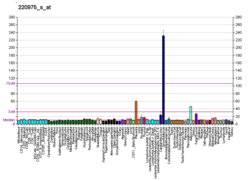| C1QTNF1 |
|---|
|
| Identifiers |
|---|
| Aliases | C1QTNF1, CTRP1, GIP, ZSIG37, C1q and tumor necrosis factor related protein 1, C1q and TNF related 1 |
|---|
| External IDs | OMIM: 610365; MGI: 1919254; HomoloGene: 10548; GeneCards: C1QTNF1; OMA:C1QTNF1 - orthologs |
|---|
| Gene location (Human) |
|---|
 | | Chr. | Chromosome 17 (human)[1] |
|---|
| | Band | 17q25.3 | Start | 79,022,814 bp[1] |
|---|
| End | 79,049,788 bp[1] |
|---|
|
| Gene location (Mouse) |
|---|
 | | Chr. | Chromosome 11 (mouse)[2] |
|---|
| | Band | 11|11 E2 | Start | 118,319,029 bp[2] |
|---|
| End | 118,340,789 bp[2] |
|---|
|
| RNA expression pattern |
|---|
| Bgee | | Human | Mouse (ortholog) |
|---|
| Top expressed in | - right coronary artery
- popliteal artery
- tibial arteries
- left coronary artery
- right auricle
- Descending thoracic aorta
- ascending aorta
- right lobe of thyroid gland
- apex of heart
- left lobe of thyroid gland
|
| | Top expressed in | - decidua
- gastrula
- lumbar spinal ganglion
- lip
- esophagus
- calvaria
- ankle
- ascending aorta
- semi-lunar valve
- aortic valve
|
| | More reference expression data |
|
|---|
| BioGPS |  | | More reference expression data |
|
|---|
|
| Gene ontology |
|---|
| Molecular function | - protein binding
- collagen binding
| | Cellular component | - extracellular region
- collagen
- integral component of plasma membrane
- extracellular space
| | Biological process | - positive regulation of cytosolic calcium ion concentration
- negative regulation of platelet activation
- protein heterotrimerization
- regulation of glucose metabolic process
- positive regulation of gene expression
- positive regulation of protein kinase B signaling
- positive regulation of aldosterone secretion
- protein homooligomerization
- negative regulation of platelet aggregation
- positive regulation of MAPK cascade
| | Sources:Amigo / QuickGO |
|
| Orthologs |
|---|
| Species | Human | Mouse |
|---|
| Entrez | | |
|---|
| Ensembl | | |
|---|
| UniProt | | |
|---|
| RefSeq (mRNA) | |
|---|
NM_030968
NM_153372
NM_198593
NM_198594 |
| |
|---|
NM_001204129
NM_001204130
NM_019959 |
|
|---|
| RefSeq (protein) | |
|---|
NP_112230
NP_699203
NP_940995
NP_940996 |
| |
|---|
NP_001191058
NP_001191059
NP_064343 |
|
|---|
| Location (UCSC) | Chr 17: 79.02 – 79.05 Mb | Chr 11: 118.32 – 118.34 Mb |
|---|
| PubMed search | [3] | [4] |
|---|
|
| Wikidata |
| View/Edit Human | View/Edit Mouse |
|


















